It’s October and the fall boat show season is just behind us. The second season of the pandemic boating boom was very busy. Supply issues, while not all fixed, are beginning to ease. Boating interest and participation have continued to be surprisingly high. And the much feared big sell off of newly purchased boats has yet to occur. One continuing issue that remains a problem for area boatshops is the labor shortage.
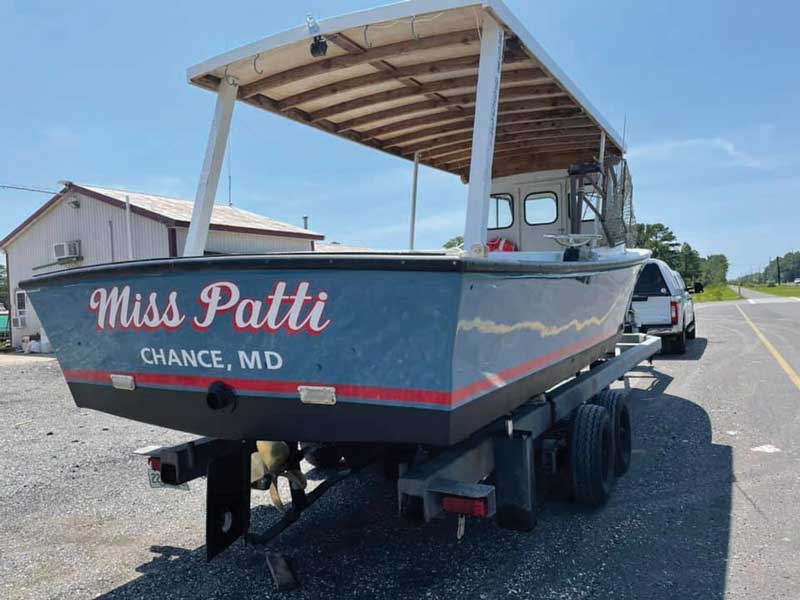
Jake Glover of Ferry Point Marina in Trappe, MD, reports in. “Our marine air conditioning and refrigeration service has been very busy. We’re doing the best we can to meet the demand. As always, the mechanics have a full schedule. The Zimmerman paint work is wrapping up. Next in line is a Tiara receiving new hull paint, barrier, and bottom paint.”
Mark Wilkins of the Calvert Marine Museum in Solomons, MD, brings us up to date with activities at the museum’s small craft shop. The shop is run by the Patuxent Small Craft Guild, a volunteer group of amateur shipwrights. “We are finishing up restoring a Pete Culler skiff that was donated to us. It needed some work; had some rot. It needed a new garboard strake on the starboard side. We replaced about half the chine on that side, which had rotted out along with the transom that had to be replaced. We also replaced some quarter knees that had rotted out. The idea is that we are restoring it and then going to give it to the local chapter of the Sea Scouts that the museum sponsors. It will be their training boat. They can row it or sail it, that sort of thing,” Mark explained. “It’s a long-term loan, subject to oversight of course,” he concluded.
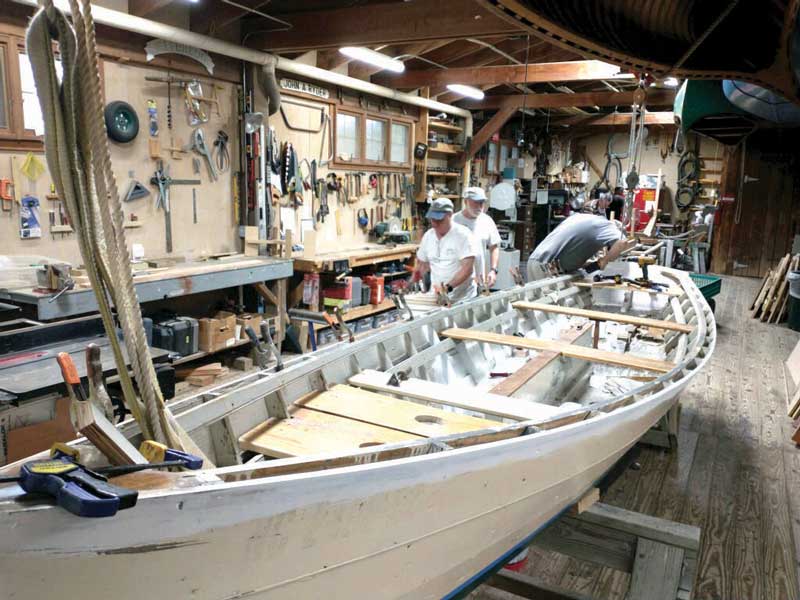
“We also just recently completed sea trials on a Poe skiff and a draketail. Both boats got new engines. The draketail got an Atomic three-cylinder diesel, and the skiff got a one lunger. Both are back in operation. We are also doing some work on Dee of St. Mary’s, our skipjack. She has some soft spots in her deck, so we are taking those out and replacing them. So, all that’s kind of keeping us busy right now. There is also an Island Creek 18 that George Surgeon, my predecessor and longtime director of this program, designed. It’s been sitting off in a corner under a tarp for three years, so we dragged that out. We’ll redo the paint and the varnish and get it back in the water and sailing, kind of a tribute to George.”
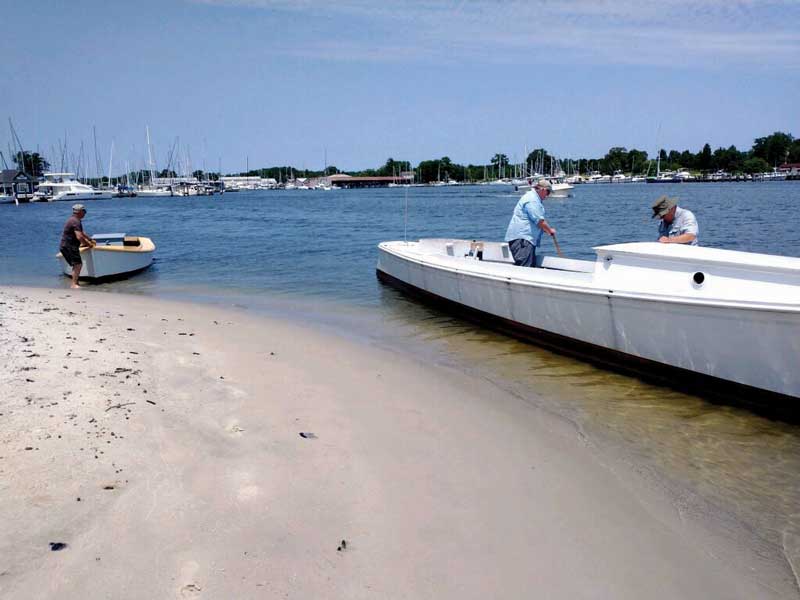
Just before press time Mark sent us this update. “Our latest news is the splashing of the Island Creek 18 that was designed and built by George Surgent, Boatwright at CMM for 40 years and who only recently retired. Our Pete Culler skiff that we’ve been restoring is ready to hand over to the Sea Scouts to be used as a rowing/sail training boat. Our draketail launch has received a new prop thus increasing her top speed to around 10 knots from six.”
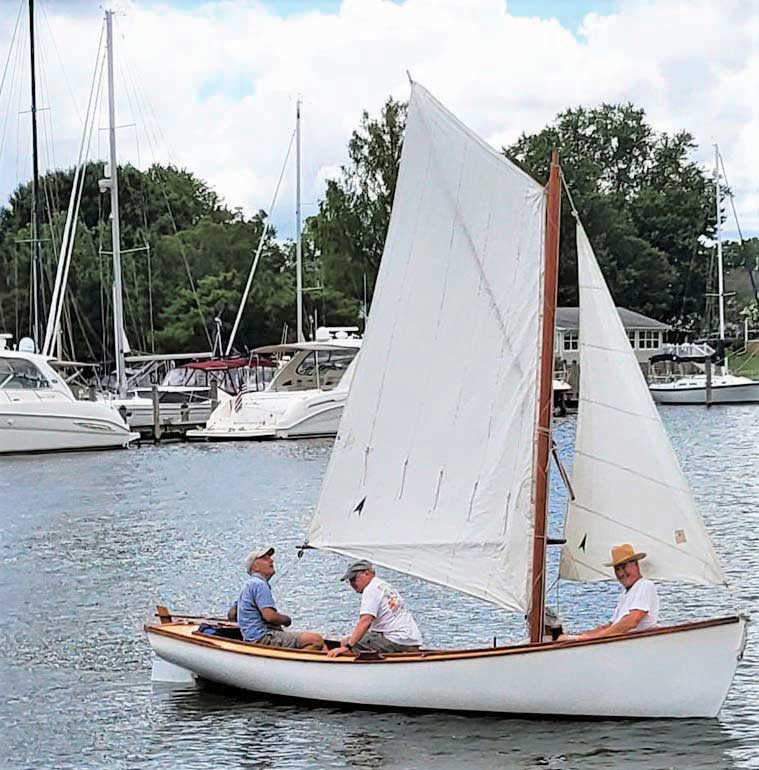
Hank Reiser of Marine Services at Pocahontas Marina in Edgewater, MD, reports that he has plenty of work to keep his crew busy until the fall haul-out season. But, like everyone, he’s having trouble finding people to do it. Hank has finished installing the engine in Stand Fast, a 1963 Lyman 19. The engines should go in the 1950 Chris-Craft Commander within the next month and she should finally be out of the tent and back in the water.
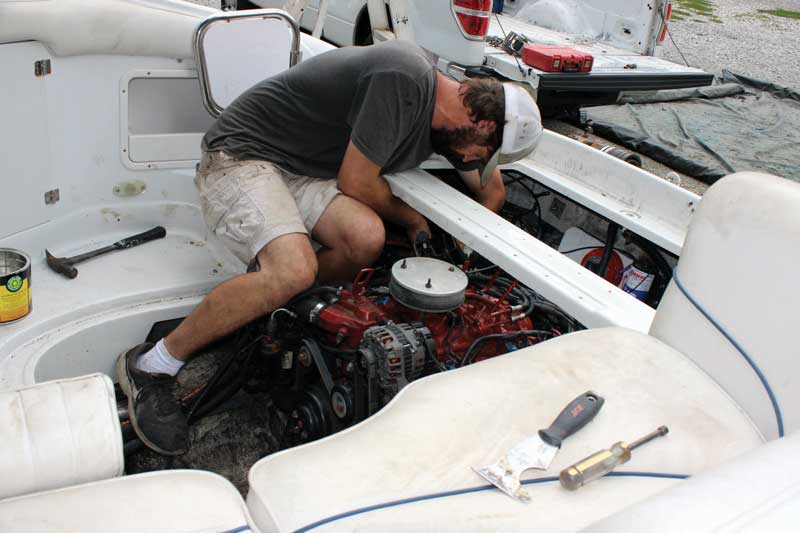
He also mentioned that he just took in Nuthatch, a 1974 fiberglass Lyman 24 for extensive deck and mechanical repairs. Hank and his helper Smokey were replacing the engine in a Crownline 24. The engine had to be removed to gain access to and replace the freeze plugs on the block which had rusted out due to raw water cooling.

Joe Reid of Mast and Mallet in Edgewater, MD, checks in. “Woodworking is a specialty at Mast and Mallet, and also repairs to cold-molded built boats. This late summer, we are working on a 2009 Windsor Craft 36, a cold-molded powerboat built in Turkey, similar to Vicem with more of a classic Chris-Craft look. It had damage to the foredeck and forward cabin surroundings. Fresh water leaks from a badly caulked windlass is suspected. Repairs were made with mahogany and mahogany ply with West epoxy and fiberglass. Finish work is with Awlgrip.

Also finishing up on a carvel planked 32-foot Brownell Bass boat. Bottom seams were all reefed and planks refastened with new Bronze fastenings. An aft section of keel was replaced from prop shaft to transom. This was due to damaged wood and a leaking rudder post. Another ongoing restoration is a 1964 Chris-Craft ski boat. We flipped the boat over, removed the bottom planks and ply sheathing. The bottom was replaced with three layers of 5 mm and 3 mm Okoume marine ply glued with West epoxy and sheathed in fiberglass. Next, we’ll put her upright and put the interior back together.”

During my last visit to the shipyard at the Chesapeake Bay Maritime Museum in St. Michaels, MD, Joe Connor, lead Shipwright on the Maryland Dove, explained the process being used to plank the replica. “All of the frames are sawn frames. The planking is spiled, steamed, and then twisted on to the boat. Once we get the planks twisted on, there is a little bit of final fitting and then they get fastened. The middles of the planks are all fastened with one-inch trunnels (tree nails, wooden rods, or dowels) that go through the plank, through the frame on the inside, and all the way through the ceiling planking and are wedged on each end. So, you are essentially creating a giant wood rivet. That’s the way that 95 percent of the boat is fastened. Where you see planks butting together, we use bronze fastenings. In the 17th century those fastenings would have been wrought iron, which was why the life expectancy for these vessels was only five to 10 years. The state wants this thing to last longer than five years, so we’ve gone away from using wrought iron,” Joe laughed. “In salt water wrought iron swells and causes some major issues as it deteriorates and completely lets go. Silicon bronze is much better suited to underwater use, so everywhere there would have been wrought iron we are using silicon bronze.”
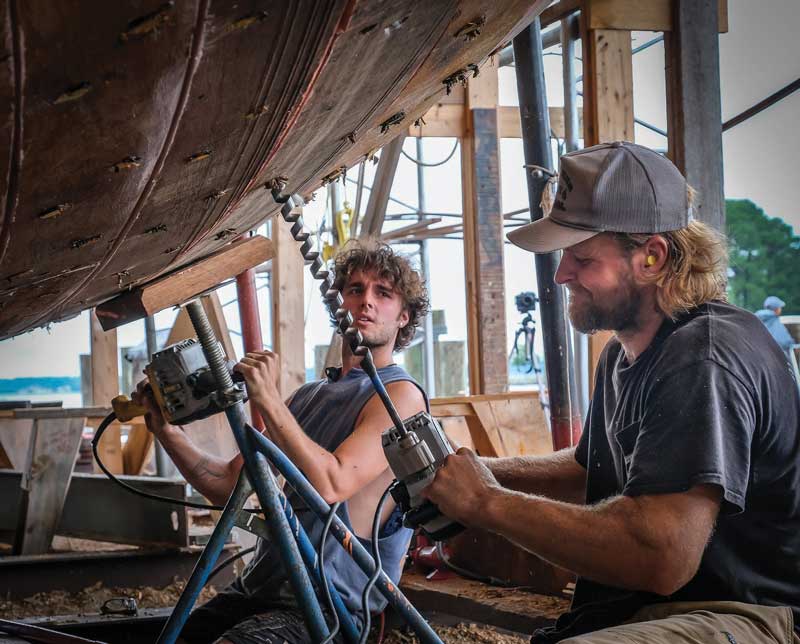
Christian Cabral, Shipyard Manager at the Chesapeake Bay Maritime Museum in St. Michaels, MD, reports the late summer and fall in CBMM’s working Shipyard have borne witness to some major milestones for both its key projects and day-to-day operations. “Chief among the accomplishments of CBMM’s shipwrights is the installation of the shutter plank on Maryland Dove. The time-honored tradition of installing the last plank on any vessel is always marked with a dram of whiskey and a perceptible change in the goals of the builders,” he explained. “The last milestone is now in clear sight—launch, completion, and delivery. Up next in the build are caulking, fairing, bulwarks, decking, deck furniture, interior installation, systems installation, and mechanical installation. CBMM’s shipwrights divide and conquer the to-do list, working feverishly toward the momentous occasion of the vessel’s initial launch. Maryland Dove, with planking, caulking, and fairing complete, will be craned into the water later in the fall. Once floating, the vessel will remain dockside at CBMM’s Shipyard as the shipwrights continue the outfit of the vessel and the installation of its rig.

Alongside the now planked Dove, the floating fleet team completed a record pace railway season. CBMM’s floating fleet of historic vessels will remain on display throughout the fall and early winter, before being winterized and stored in their winter berths. As always, completion of the railway season means the team changes its priorities to long-term projects. This winter, that project is Maryland Dove. Beginning in September, CBMM’s floating fleet team will add their formidable talent to the completion of this new state icon, participating in all aspects of the vessel’s completion and delivery. To learn more, visit marylanddove.org.”
Enjoy the lovely fall weather!